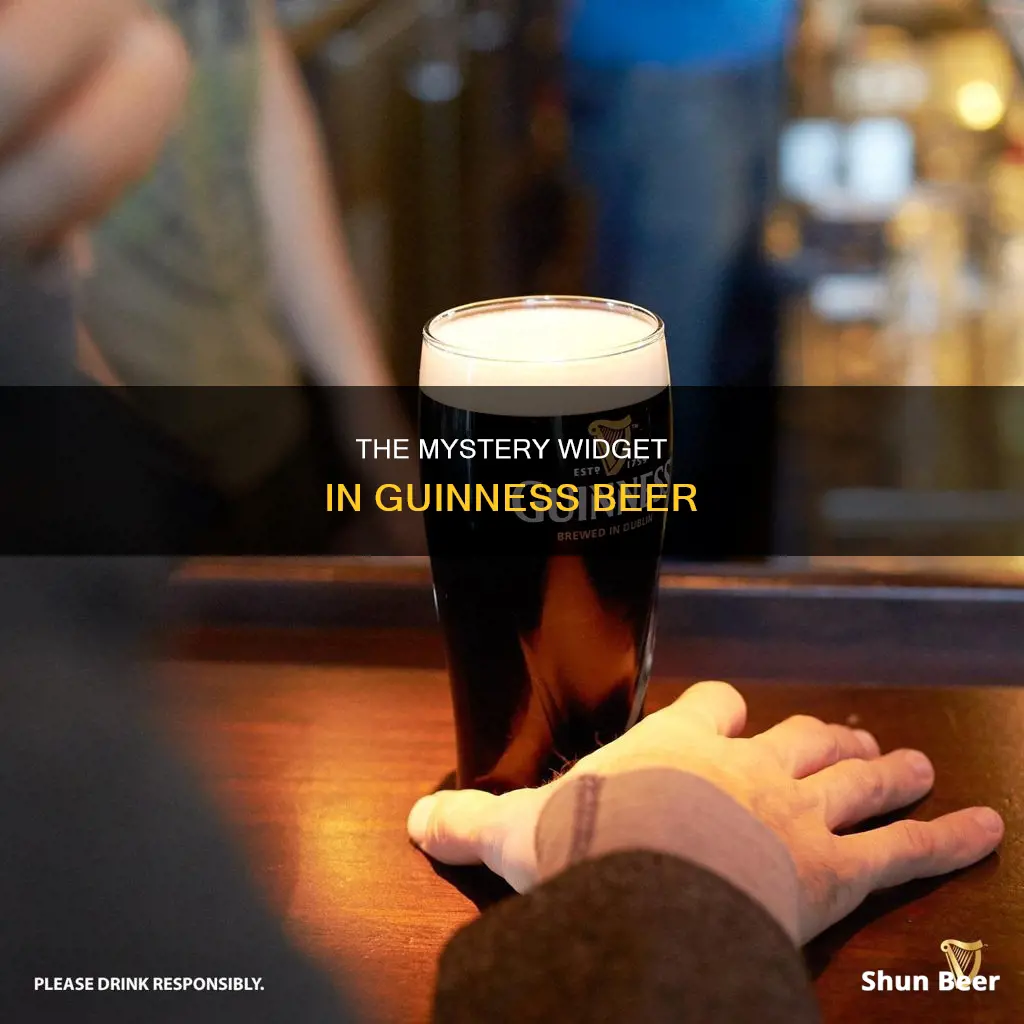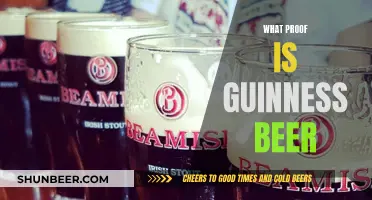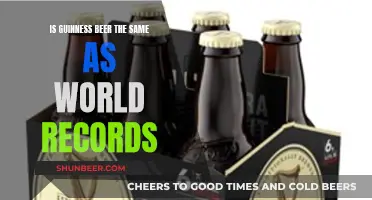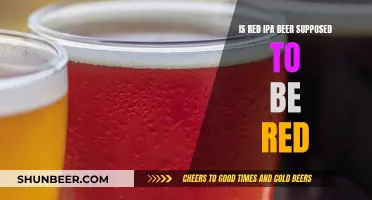
If you've ever opened a can or bottle of Guinness, you may have heard a strange rattling sound. This is a small plastic device called a widget, which gives Guinness its signature creamy head. The widget was developed by Guinness in 1969 and patented in Ireland, though it wasn't released until 1989. It is a hollow, spherical piece of plastic with a tiny hole in it, and it works by adding pressurised nitrogen to the beer during the canning process. When the can is opened, the pressure drops and the nitrogenated beer is forced out of the widget, creating a burst of tiny bubbles that give Guinness its thick, creamy head.
| Characteristics | Values |
|---|---|
| Name | Widget |
| Material | Food-grade plastic |
| Shape | Hollow sphere |
| Size | 3 centimetres in diameter |
| Hole | Yes |
| Seam | Yes |
| Function | Manage the characteristics of the beer's head |
| Inventor | John Lunn, Master Distiller |
| Patented | 1969 |
| Debut | 1989 |
| First Generation | Flattened sphere |
| Floating Widget/Smoothifier | Debuted in 1997 |
What You'll Learn

The widget's design and function
The widget is a small plastic ball that is placed inside Guinness beer cans during the canning process. It is hollow and spherical, with a diameter of approximately 3 centimetres (similar in appearance to a ping pong ball), and has a tiny hole in it. During canning, pressurised liquid nitrogen is added to the brew, which quickly evaporates, creating pressure inside the can. This forces gas and liquid into the widget through its tiny hole.
When the can is opened, the pressure inside the can drops, and the nitrogenated beer inside the widget is forced out through the same small hole, creating a foamy head. This process is called "jetting" and results in a thick, creamy head similar to that of a freshly poured draught beer. The widget thus helps to maintain the quality and taste of the beer, giving it a smoother and more delicate flavour compared to beer carbonated with carbon dioxide.
The floating widget was introduced by Guinness in 1997 to address the issue of beer overflowing when served warm in cans with the first-generation widget, which was a flattened disc that sat at the bottom of the can. The floating widget, also known as the "Smoothifier", does not have this problem and can be found in cans of Guinness today.
In addition to the floating widget for cans, Guinness also has a "rocket widget" for bottles. This widget is shaped like a rocket and is approximately 7 centimetres in length, with a small hole at the bottom. The bottle widget is designed for the beer to be enjoyed straight from the bottle, while the canned beer with the floating widget is meant to be poured into a glass after opening.
Guinness Beer: Available in Kolkata?
You may want to see also

Why Guinness uses nitrogen instead of carbon dioxide
Nitrogen is used in Guinness beer to create a smoother, subtler fizz, resulting in a thick and creamy texture and taste. Nitrogen bubbles are smaller than carbon dioxide bubbles, which gives the brew a more velvety "mouthfeel" without the acidic bite of carbonation. In fact, Guinness was the world's first nitro beer.
While many other beers are brewed using carbon dioxide, the brew masters at Guinness use nitrogen. The smaller bubbles create a smoother, subtler fizz, making it taste thick and creamy. The nitrogen also gives Guinness its signature velvet head.
Breweries typically use carbon dioxide to give a beer its quintessential bitter fizz. But when a drink calls for a sweeter, silkier experience—like when drinking a Guinness—brewers infuse the ale with nitrogen rather than carbon dioxide. Guinness is carbonated and served with a blend of carbon dioxide and nitrogen at a ratio of 30/70. The key part here is the nitrogen. Nitrogen creates smaller bubbles, giving Guinness its signature creamy head, but it is far less soluble than carbon dioxide when dissolved in liquid (100 times less soluble, in fact).
For years, the brewers at Guinness struggled to export that Irish flavor in bottles and cans. On tap, the nitrogen created the perfect creamy texture, but the packaging process created a major challenge. In order to use nitrogen in the can or bottle, the brewers would need a dangerous level of pressure, and the nitrogen could easily escape during the canning process. To solve this problem, Guinness brewers invented something called a widget. The small piece of plastic, inside each can and bottle of Guinness beer, absorbs nitrogen during the packaging process. And when a customer opens the can, the widget releases a tiny jet of nitrogen bubbles to create the perfect taste, just like you'd get from a tap.
Guinness: A Dessert Beer? Exploring the Unique Taste of Guinness
You may want to see also

The history of the widget
The widget is a small, plastic ball found in Guinness beer cans and bottles. But how did it come to be? Well, it all started in 1969 when Guinness brewers Tony Carey and Sammy Hildebrand patented the idea of a widget. The goal was to create a system that could produce draught-type Guinness from cans or bottles by discharging gas from an internal compartment. This system was successfully patented in British Patent No 1266351, filed on 27 January 1969, with a complete specification published on 8 March 1972.
However, it wasn't until two decades later, in 1989, that Guinness released their first-generation widget to the public. This widget was a flattened plastic disc that sat at the bottom of the can. While it worked well for serving cold beer, it had a tendency to overflow if the beer was served warm. Undeterred, Guinness continued to innovate and, in 1997, they released the floating, spherical widget known as the "Smoothifier". This new design successfully addressed the issue of overflow and became a staple of Guinness cans.
The widget's unique design and functionality have played a pivotal role in enhancing the taste and texture of Guinness beer. By infusing the ale with nitrogen, the widget creates a smoother and more delicate flavour compared to the bitterness of carbon dioxide fizz. This innovation not only revolutionised the beer-drinking experience but also set a new standard for the industry.
The popularity of widgets has spread beyond Guinness, with other beers such as Old Speckled Hen, Young's Double Chocolate Stout, and Murphy's Stout adopting similar devices in their cans. The success of the widget is a testament to the ingenuity and perseverance of the Guinness brewers, who continue to refine their brewing techniques to deliver the perfect pint.
Guinness Beer: Carcinogen Concerns and Consumption
You may want to see also

How the widget affects the taste
The widget in a can of Guinness is a small, plastic, floating device that is added to cans and bottles of Guinness draught. The widget was invented in the early 1990s and has become an essential part of the Guinness draught experience. When activated, it releases nitrogen into the beer, giving it a creamy, velvety texture and enhancing its aroma and flavour.
Nitrogen is essential to the taste of Guinness. Breweries typically use carbon dioxide to give a beer its quintessential bitter fizz, but when a drink calls for a smoother, silkier experience, brewers infuse the ale with nitrogen instead. Nitrogen bubbles are smaller than carbon dioxide bubbles, so the resulting head and taste are smoother and more delicate.
The widget plays a crucial role in delivering this nitrogen to the beer. During the canning process, brewers add liquid or pressurised nitrogen to the beer, which evaporates and expands, forcing gas and liquid into the widget through a tiny hole. When the can is opened, the pressure drops, and the nitrogenated beer inside the widget is forced out, creating a burst of tiny bubbles that rise to the top of the beer. This not only gives Guinness its signature creamy head but also enhances the overall taste experience.
The widget's design is carefully engineered to achieve this desired effect. It is typically a hollow, spherical piece of food-grade plastic with a tiny hole, similar in appearance to a ping pong ball. The strategic positioning of the widget within the can and the sealing of the can in a nitrogen-rich environment ensure that Guinness's distinct characteristics are maintained throughout storage and transportation.
Without the widget, it would be challenging to maintain the desired levels of nitrogen in packaged beers once they are opened. The widget provides a simple engineering solution, allowing a slow release of nitrogen into the beer upon opening, thus delivering the iconic taste and texture of Guinness to consumers worldwide.
Abita Beer's Dark, Creamy Guinness-like Brews Revealed
You may want to see also

Other beers that use widgets
The widget is a device placed in a container of beer to manage the characteristics of the beer's head. The original widget was patented in Ireland by Guinness. Other beers that have adopted the widget technology include:
Young's Double Chocolate Stout
Young's Double Chocolate Stout is a milk stout with 5% alcohol, brewed by Wells and Young in the United Kingdom. It has a nice sweet bite to the taste, coming from the chocolate malt.
Murphy's Stout
Murphy's Stout is a low-alcohol (4%) Irish cream stout from Cork, Ireland. It has more flavour than Guinness and the can taste very similar to the stout served in Irish pubs.
Boddington's Pub Ale
Boddington's Pub Ale is brewed in Manchester, England, with an ABV of 4.7%. It starts out creamy when poured and has a nice simple taste.
Old Speckled Hen
Old Speckled Hen is a bitter with a 5.2% ABV, originated in Abington, Oxfordshire, in 1979, to commemorate the fiftieth anniversary of the MG plant. It has a very nice taste.
John Smith's Smooth Ale
John Smith's Smooth Ale is a smooth, mild (3.6%), creamy English pale ale dating back to 1778 in Tadcaster, North Yorkshire, England. It is the biggest sponsor of horse racing in the UK.
Guinness Beer: Sour or Not?
You may want to see also
Frequently asked questions
The plastic widget is a small, hollow, spherical piece of plastic with a tiny hole in it. It was developed by Guinness in 1969 and is sometimes referred to as a "Smoothifier".
The widget is used to give canned Guinness a silky, creamy head, similar to a freshly poured draught beer.
During the canning process, brewers add pressurised nitrogen to the beer, which trickles into the widget along with a small amount of beer. When the can is opened, the pressure inside the can equalises with the room, but the pressure inside the widget remains high, causing the nitrogenated beer to squirt into the beer, creating a burst of tiny bubbles that rise to the top of the liquid.







